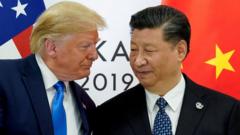In a statement posted on his social media platform, Truth Social, President Trump conveyed that the just-concluded talks have resulted in an agreement with China for the supply of magnets and rare earth metals to US companies. In exchange, the US plans to retract its threats to revoke visas for Chinese students, pending the final approval of both President Trump and Chinese President Xi Jinping.
The negotiations are seen as a continuation of efforts to ease longstanding tensions that have escalated over the past year, especially after tariffs significantly impacted bilateral trade. This deal comes after two days of discussions in London, a follow-up to the reconciliation attempts that began after a truce was established in May, amidst increasing tariffs that had given rise to trade hostilities.
Details surrounding the agreement remain sparse; however, Chinese Vice Commerce Minister Li Chenggang confirmed there is a framework in place aimed at executing the consensus formed between the two leaders in earlier communications. US Commerce Secretary Howard Lutnick further supported this by expressing optimism about the framework’s potential for furthering negotiations moving forward.
The backdrop to the negotiations includes the US expressing concerns over the pace at which China was exporting vital rare earth minerals necessary for various industries ranging from smartphones to electric vehicles. Conversely, China has scrutinized the restrictions placed by the US on crucial semiconductor technologies and the limitations on student visas.
Despite the promising tone from both sides, experts emphasize that the agreement's scope is limited, revealing it to be more of a minor recalibration rather than a full-fledged resolution to the trade standoff. Observers indicated that significant hurdles remain and that a comprehensive trade agreement will take considerable time to develop.
The market response to the news has been subdued, highlighting the cautious optimism prevalent in the atmosphere surrounding US-China trade relations and the potential implications on global economic stability as the two powers navigate their complex relationship.
As both nations await final approvals from the respective presidents, the broader landscape around US-China trade remains intricate, with observers wary of future developments and their ramifications on international trade.
The negotiations are seen as a continuation of efforts to ease longstanding tensions that have escalated over the past year, especially after tariffs significantly impacted bilateral trade. This deal comes after two days of discussions in London, a follow-up to the reconciliation attempts that began after a truce was established in May, amidst increasing tariffs that had given rise to trade hostilities.
Details surrounding the agreement remain sparse; however, Chinese Vice Commerce Minister Li Chenggang confirmed there is a framework in place aimed at executing the consensus formed between the two leaders in earlier communications. US Commerce Secretary Howard Lutnick further supported this by expressing optimism about the framework’s potential for furthering negotiations moving forward.
The backdrop to the negotiations includes the US expressing concerns over the pace at which China was exporting vital rare earth minerals necessary for various industries ranging from smartphones to electric vehicles. Conversely, China has scrutinized the restrictions placed by the US on crucial semiconductor technologies and the limitations on student visas.
Despite the promising tone from both sides, experts emphasize that the agreement's scope is limited, revealing it to be more of a minor recalibration rather than a full-fledged resolution to the trade standoff. Observers indicated that significant hurdles remain and that a comprehensive trade agreement will take considerable time to develop.
The market response to the news has been subdued, highlighting the cautious optimism prevalent in the atmosphere surrounding US-China trade relations and the potential implications on global economic stability as the two powers navigate their complex relationship.
As both nations await final approvals from the respective presidents, the broader landscape around US-China trade remains intricate, with observers wary of future developments and their ramifications on international trade.





















